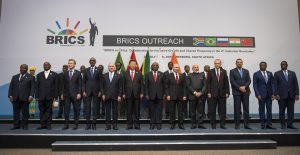India announced on August 30 that it will not participate in the Kavkaz-2020 military exercise in southern Russia involving members of the Shanghai Cooperation Organization (SCO) — a Eurasian multilateral grouping led by China and Russia, which also has Pakistan as a member – and a few others. While the official reason New Delhi provided for this decision was difficulties associated with the COVID-19 pandemic, Indian sources have pointed out that the country decided to skip Kavkaz-2020 due to the participation of the Chinese military in the exercises. India and China are in the middle of a tense standoff since early May this year in eastern Ladakh.
India’s decision to stay out of the Kavkaz-2020 once again brings to question why India decided to join the SCO – or why it has accorded notional importance to groupings like BRICS as well as the Russia-India-China (RIC) trilateral – in the first place even as it deepens its strategic relationship with the United States and allied powers in the Indo-Pacific.
Writing in The Diplomat in January this year, Krzysztof Iwanek assessed the costs and benefits of India’s SCO membership. But what many fail to appreciate at a first glance is how contingent, historically speaking, arrangements such as the SCO, BRICS or RIC have been for Russia on its relationship with the West as it sought to first align itself with that bloc immediately after the end of the Cold War and then pivot away from it and rebrand itself as an Asian power.
In the Russian thinking about its role in the post-Cold War world, Moscow would emerge as an equal to the United States and be accorded commensurate importance. Building bridges with the West became a key project of Russian President Boris Yeltsin’s first foreign minister, the liberal Andrei Kozyrev. Oddly enough, Russia’s brief flirtation with liberalism did not extend to the world’s largest democracy. As Rajan Menon writes of this period: “Russian leaders did not regard India as critical to their country’s wider interests; they saw the United States, Europe, and China as the loci of economic and political power. The alignment with India seemed relic of the communist past.”
For a variety of reasons best explained by Russia’s status-seeking behavior, Moscow was to soon turn its back to the West and toward Asia, the calculation in the Kremlin being that such a reorientation would restore Russia’s former position in the international system. A fundamentally key step in this direction was the visit by Yeltsin’s second foreign minister, Yevgeny Primakov, to New Delhi in 1998 where he first floated the concept of the RIC to balance U.S. power while, in the backdrop, NATO continued to bomb Serbia without waiting for Moscow’s nod. RIC would become the political nucleus for BRICS — a grouping that takes reforms of key multilateral institutions to reflect the interests of the non-western world as a key task — in due time. (Ironically enough, the very fact that Russia was proposing balancing coalitions such as RIC was, in effect, an implicit admission that Russia was no longer a great power which could take on American unilateralist impulses on its own.)
Following the Yeltsin years, despite Putin’s early optimism about a possible entente with the West, he increasingly began to present his country as a leader of the “non-West.” As early as June 2001, he was hedging his bets when it came to cultivating closer ties with the U.S. That month, the SCO was created, building on the Shanghai Five arrangement of 1996, with Russia, China, Kazakhstan, Kyrgyzstan, Tajikistan, and Uzbekistan – as the sixth entrant — as founding members. India and Pakistan became full members of the grouping in 2017.
Together with Foreign Minister Sergei Lavrov, Putin’s programmatic vision for a “non-West” with Russian leadership revolved around BRICS, RIC as well as the SCO. But suspicions between Russia and China, fueled by history as well as power asymmetries, never quite faded away from the scene. Therefore, the only way Moscow could advance its normative agenda of “multipolarity” by borrowing Chinese heft, so to speak, through alternative institutions and groupings was by bringing India in as a “balancing” force within them.
But as Stanislaw Skarzynski and Daniel Wong recently wrote in these pages, cracks in the Russia-China relationship are beginning to show and there is a small though distinct possibility that Moscow might seek to pivot back to the West. And this is where India could serve as a valuable link to the United States — and the Indian decision to persuade Russia to accept the Indo-Pacific construct finds its proper context. New Delhi is keenly aware of how Moscow’s quest for status in the international system has, in the past, led it to instrumentally partner with China and how, because of the same reason, it can also jettison Beijing in the future.

































